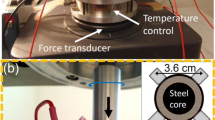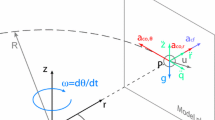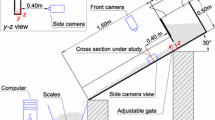Abstract
Knowledge about the interaction between granular flow and fluid (gas) is essential for understanding dynamics. In this study, a series of experiments designed with different conditions were conducted using a flume configuration to investigate the dynamics of particle flow by directly measuring the basal gas pressure, normal force, and shear force. The results show that the basal gas pressure is a positive value, reaching and remaining at the bottom of the slider before the granular flow, which increases with inclination angle but has little support for the solid skeleton of the flow. (The ratio to normal pressure is ~ 2%.) After the flow depth decreases, the gas pressure shows a negative value, which may be the result of the slight expansion of the sliding body. Ultimately, an unstable negative pressure can be generated after the main body passes through. The dynamic characteristics of our experimental flow are strongly related to particle size, as shown by the inverse relationship between the effective basal friction coefficient and particle size, which we explain with force fluctuations. For granular flow with a high content of coarse particles, the fluctuations of the normal force and shear force (normalized standard deviation) and effective basal friction coefficient are all negatively correlated, which shows that a high-amplitude pulsating force promotes particle propagation, and shear force fluctuation plays an important role, which is approximately 2–3 times the normal force fluctuation. The generation of a high-amplitude pulsating force is attributed to high-frequency, dense particle collisions at the grain scale, which is mainly determined by the grain size and magnified as the angle increases.












Similar content being viewed by others
Data availability
The data used to support the findings of this study are included in this paper.
References
Allstadt KE, Farin M, Iverson RM, Obryk MK, Kean JW, Tsai VC, Rapstine TD, Logan M (2020) Measuring basal force fluctuations of debris flows using seismic recordings and empirical green’s functions. J Geophys Res Earth Surf 125:e2020JF005590. https://doi.org/10.1029/2020JF005590
Arran MI, Mangeney A, De Rosny J, Farin M, Toussaint R, Roche O (2021) Laboratory landquakes: Insights from experiments into the high-frequency seismic signal generated by geophysical granular flows. J Geophys Res Earth Surf 126:e2021JF006172. https://doi.org/10.1029/2021JF006172
Berti M, Genevois R, Simoni A, Tecca PR (1999) Field observations of a debris flow event in the dolomites. Geomorphology 29:265–274. https://doi.org/10.1016/S0169-555X(99)00018-5
Breard ECP, Dufek J, Roche O (2019) Continuum modeling of pressure-balanced and fluidized granular flows in 2-D: comparison with glass bead experiments and implications for concentrated pyroclastic density currents. J Geophys Res Solid Earth 124:5557–5583. https://doi.org/10.1029/2018JB016874
Brodu N, Delannay R, Valance A, Richard P (2015) New patterns in high-speed granular flows. J Fluid Mech 769:218–228. https://doi.org/10.1017/jfm.2015.109
Cagnoli B, Romano GP (2012) Effects of flow volume and grain size on mobility of dry granular flows of angular rock fragments: a functional relationship of scaling parameters. J Geophys Res Solid Earth. https://doi.org/10.1029/2011JB008926
Cagnoli B, Romano GP (2012) Granular pressure at the base of dry flows of angular rock fragments as a function of grain size and flow volume: A relationship from laboratory experiments. J Geophys Res Solid Earth. https://doi.org/10.1029/2012JB009374
Cruden DM, Hungr O (1986) The debris of the frank slide and theories of rockslide–avalanche mobility. Can J Earth Sci 23(3):425–432. https://doi.org/10.1139/e86-044
Davies T, McSaveney M (2012) Mobility of long-runout rock avalanches. In: Stead D, Clague JJ (eds) Landslides: Types, mechanisms and modeling. Cambridge University Press, Cambridge, pp 50–58. https://doi.org/10.1017/CBO9780511740367.006
De Blasio FV, Elverhøi A (2008) A model for frictional melt production beneath large rock avalanches. J Geophys Res 113:F02014. https://doi.org/10.1029/2007JF000867
De Blasio FV (2014) Friction and dynamics of rock avalanches travelling on glaciers. Geomorphology 213:88–98. https://doi.org/10.1016/j.geomorph.2014.01.001
Dent J, Burrell K, Schmid D, Louge M, Adams E, Jazbutis T (1998) Density, velocity and friction measurements in a dry-snow avalanche. Ann Glaciol 26:247–252. https://doi.org/10.3189/1998AoG26-1-247-252
Di Luzio E, Bianchi-Fasani G, Esposito C, Saroli M, Cavinato GP, Scarascia-Mugnozza G (2004) Massive rock-slope failure in the central apennines (Italy): the case of the campo di giove rock avalanche. Bull Eng Geol Environ 63:1–12. https://doi.org/10.1007/s10064-003-0212-7
Duan Z, Wu Y-B, Peng J-B, Xue S-Z (2022) Characteristics of sand avalanche motion and deposition influenced by proportion of fine particles. Acta Geotech. https://doi.org/10.1007/s11440-022-01653-y
Farin M, Mangeney A, Roche O (2014) Fundamental changes of granular flow dynamics, deposition, and erosion processes at high slope angles: Insights from laboratory experiments. J Geophys Res Earth Surf 119:504–532. https://doi.org/10.1002/2013JF002750
Forterre Y, Pouliquen O (2008) Flows of dense granular media. Annu Rev Fluid Mech 40:1–24. https://doi.org/10.1146/annurev.fluid.40.111406.102142
Gauer P, Issler D (2004) Possible erosion mechanisms in snow avalanches. Ann Glaciol 38:384–392. https://doi.org/10.3189/172756404781815068
Holyoake AJ, McElwaine JN (2012) High-speed granular chute flows. J Fluid Mech 710:35–71. https://doi.org/10.1017/jfm.2012.331
Hsu L, Dietrich WE, Sklar LS (2008) Experimental study of bedrock erosion by granular flows. J Geophys Res 113:F02001. https://doi.org/10.1029/2007JF000778
Hsu L, Dietrich WE, Sklar LS (2014) Mean and fluctuating basal forces generated by granular flows: laboratory observations in a large vertically rotating drum. J Geophys Res Earth Surf 119:1283–1309. https://doi.org/10.1002/2013JF003078
Huang Y, Zhang W, Xu Q, Xie P, Hao L (2012) Run-out analysis of flow-like landslides triggered by the Ms 8.0 2008 Wenchuan earthquake using smoothed particle hydrodynamics. Landslides 9:275–283. https://doi.org/10.1007/s10346-011-0285-5
Hungr O, Leroueil S, Picarelli L (2014) The Varnes classification of landslide types, an update. Landslides 11:167–194. https://doi.org/10.1007/s10346-013-0436-y
Iverson RM (1997) The physics of debris flows. Rev Geophys 35:245–296. https://doi.org/10.1029/97RG00426
Iverson RM, Logan M, LaHusen RG, Berti M (2010) The perfect debris flow? aggregated results from 28 large-scale experiments. J Geophys Res 115:F03005. https://doi.org/10.1029/2009JF001514
Iverson RM, Vallance JW (2001) New views of granular mass flows. Geol 29:115. https://doi.org/10.1130/0091-7613(2001)029%3c0115:NVOGMF%3e2.0.CO;2
Jibson RW, Harp EL, Schulz W, Keefer DK (2006) Large rock avalanches triggered by the m 7.9 denali fault, alaska, earthquake of 3 november 2002. Eng Geol 83:144–160. https://doi.org/10.1016/j.enggeo.2005.06.029
Kaitna R, Palucis MC, Yohannes B, Hill KM, Dietrich WE (2016) Effects of coarse grain size distribution and fine particle content on pore fluid pressure and shear behavior in experimental debris flows. J Geophys Res Earth Surf 121:415–441. https://doi.org/10.1002/2015JF003725
Li K, Wang Y, Cheng Q, Lin Q, Wu Y, Long Y (2022) Insight into granular flow dynamics relying on basal stress measurements: From experimental flume tests. J Geophys Res Solid Earth 127:e2021JB022905. https://doi.org/10.1029/2021JB022905
Louge MY, Keast SC (2001) On dense granular flows down flat frictional inclines. Phys Fluids 13:1213–1233. https://doi.org/10.1063/1.1358870
Lucas A, Mangeney A, Ampuero JP (2014) Frictional velocity-weakening in landslides on earth and on other planetary bodies. Nat Commun 5:3417. https://doi.org/10.1038/ncomms4417
Mancarella D, Hungr O (2010) Analysis of run-up of granular avalanches against steep, adverse slopes and protective barriers. Can Geotech J 47:827–841. https://doi.org/10.1139/T09-143
McCoy SW, Tucker GE, Kean JW, Coe JA (2013) Field measurement of basal forces generated by erosive debris flows: DEBRIS FLOW BASAL FORCE. J Geophys Res Earth Surf 118:589–602. https://doi.org/10.1002/jgrf.20041
McElwaine J, Nishimura K (2001) Ping-pong ball avalanche experiments. Ann Glaciol 32:241–250. https://doi.org/10.3189/172756401781819526
McElwaine JN, Turnbull B (2005) Air pressure data from the vallée de la sionne avalanches of 2004. J Geophys Res Earth Surf. https://doi.org/10.1029/2004JF000237
Miao T, Liu Z, Niu Y, Ma C (2001) A sliding block model for the runout prediction of high-speed landslides. Can Geotech J 38:217–226. https://doi.org/10.1139/t00-092
Penna IM, Hermanns RL, Nicolet P, Morken OA, Dehls J, Gupta V, Jaboyedoff M (2020) Airblasts caused by large slope collapses. GSA Bull 133:939–948. https://doi.org/10.1130/B35531.1
Preuth T, Bartelt P, Korup O, McArdell BW (2010) A random kinetic energy model for rock avalanches: Eight case studies. J Geophys Res 115:F03036. https://doi.org/10.1029/2009JF001640
Roche O, Montserrat S, Niño Y, Tamburrino A (2010) Pore fluid pressure and internal kinematics of gravitational laboratory air-particle flows: Insights into the emplacement dynamics of pyroclastic flows. J Geophys Res 115:B09206. https://doi.org/10.1029/2009JB007133
Roche O, Niño Y, Mangeney A, Brand B, Pollock N, Valentine GA (2013) Dynamic pore-pressure variations induce substrate erosion by pyroclastic flows. Geology 41:1107–1110. https://doi.org/10.1130/G34668.1
Roche O, van den Wildenberg S, Valance A, Delannay R, Mangeney A, Corna L, Latchimy T (2021) Experimental assessment of the effective friction at the base of granular chute flows on a smooth incline. Phys Rev E 103:042905. https://doi.org/10.1103/PhysRevE.103.042905
Savage SB (1984) The mechanics of rapid granular flows. Adv Appl Mech 24:289–366. https://doi.org/10.1016/s0065-2156(08)70047-4
Shreve RL (1968) The blackhawk landslide. Geological Society of America, Special Paper 108: 0–47. https://doi.org/10.1130/SPE108-p1
Turnbull B, McElwaine JN (2008) Experiments on the non-boussinesq flow of self-igniting suspension currents on a steep open slope. J Geophys Res 113:F01003. https://doi.org/10.1029/2007JF000753
Turnbull B, McElwaine JN (2010) Potential flow models of suspension current air pressure. Ann Glaciol 51:113–122. https://doi.org/10.3189/172756410791386490
Yan K, He J, Cheng Q, Zhang J, Fuentes R (2021) Experimental investigation on the interaction between rapid dry gravity-driven debris flow and array of obstacles. Landslides 18:1761–1778. https://doi.org/10.1007/s10346-020-01614-0
Zhang M, Yin Y (2013) Dynamics, mobility-controlling factors and transport mechanisms of rapid long-runout rock avalanches in china. Eng Geol 167:37–58. https://doi.org/10.1016/j.enggeo.2013.10.010
Zhang Z, Walter F, McArdell BW, De Haas T, Wenner M, Chmiel M, He S (2021) Analyzing bulk flow characteristics of debris flows using their high frequency seismic signature. J Geophys Res Solid Earth. https://doi.org/10.1029/2021JB022755
Zhang B, Huang Y (2022) Impact behavior of superspeed granular flow: Insights from centrifuge modeling and DEM simulation. Eng Geol 299:106569. https://doi.org/10.1016/j.enggeo.2022.106569
Zhu Y, Delannay R, Valance A (2020) High-speed confined granular flows down smooth inclines: scaling and wall friction laws. Granul Matter 22:82. https://doi.org/10.1007/s10035-020-01053-7
Zhuang Y, Xu Q, Xing A (2019) Numerical investigation of the air blast generated by the Wenjia valley rock avalanche in Mianzhu, Sichuan, China. Landslides 16:2499–2508. https://doi.org/10.1007/s10346-019-01253-0
Acknowledgements
This work was supported by the National Key Research and Development program of China (Project No.2022YFF0800604), the Major Program of the National Natural Science Foundation of China (Grant No.41877266; No.42090051), the Youth Innovation Promotion Association of the Chinese Academy of Sciences (2021373), and China Railway Design Corporation (Project No. 2020YY340408).
Author information
Authors and Affiliations
Corresponding authors
Ethics declarations
Conflict of interest
The authors declare that they have no known competing financial interests or personal relationships that could have appeared to influence the work reported in this paper.
Additional information
Publisher's Note
Springer Nature remains neutral with regard to jurisdictional claims in published maps and institutional affiliations.
Rights and permissions
Springer Nature or its licensor (e.g. a society or other partner) holds exclusive rights to this article under a publishing agreement with the author(s) or other rightsholder(s); author self-archiving of the accepted manuscript version of this article is solely governed by the terms of such publishing agreement and applicable law.
About this article
Cite this article
Yu, X., Wang, D., He, S. et al. Experimental determination of basal gas pressure and effective coefficient of friction for dry granular flow. Acta Geotech. 18, 3889–3904 (2023). https://doi.org/10.1007/s11440-023-01817-4
Received:
Accepted:
Published:
Issue Date:
DOI: https://doi.org/10.1007/s11440-023-01817-4




